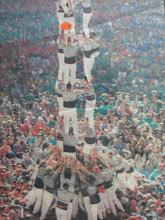Wednesday, 3 March 2010
back in your grill, briefly
Tuesday, 6 October 2009
tropa macaca
reference mania/found images
Something I have been turning over in my head recently is the use of references as the major component of a work in the field of cultural production, or more critically, I sense, as a justification for its relevance or quality.
The idea discussed here is manoeuvrable enough to cover music, critical theory and cultural journalism, amongst other things, but here it is mainly a reaction to contemporary art.
What I am concerned about is when people will use a lofty or esteemed concept, predecessor, historical event, scientific fact, cult musician or suchlike, usually in essence something really fascinating (but sometimes not) that will bestow quality or profundity by association.
Of course it is difficult to ascertain ultimate possession of ideas or material in something that is presented, or even, at a more prosaic level, in everyday conversation when talking about interests. With some people i know i find it difficult to have a conversation without name-dropping things, rather than actually discussing them properly. Branding something, in the media or even to the level of intimate interaction, is rife within cultural practices and its attendant and layered spheres. And of course, there is not enough time to talk about everything in detail, or even the inclination.
I am not disputing the form of appropriation as a critical and relevant procedure, it has formed a large part of many practices for a long time. Indeed it is very difficult to contribute something significant without reference the network of things it relates to, and indeed there are many people who investigate this processing of information and cultural artefacts in an involved and committed way. Talking about the network of ideas that a work exists in is essential to it having any relevance, and I am not suggesting that it should be isolated and pure from any interference or discussion.
Somebody (among many) who I see as doing this well is the publishing house Dexter Sinister. Recently I went to see a talk by David Reinfurt (one of the founders) with whom it was obvious that the fluidity of references or cultural objects circling between contexts and the consequent reflections and subversions of these machinations really made him tick.
(Here i go, referencing something without talking about it in depth! This is consciously the only example I want to use here-a complimentary one.)
What I do feel I am seeing often, however, is uninteresting work using something that is actually interesting as a crutch, that the ideas referenced are actually more the substance of the work than the work itself.
This is wholly passable if the practice in case is mainly discourse itself, but sometimes I feel I am seeing something pretty being linked to something interesting that makes it seem clever, with no mediation and transformation of this something into the work presented. An empty name-checking to insulate from a lack of actual creation, and taking someone elses work as the content for your own without an engagement of it or a defined critical perspective on this contributing to the work itself, without acknowledging this borrowing as a deliberate strategy, rather assuming it as a given right. Here lies an uneasy balance between medium and intent, to clarify I am not trying to divide form and content. If the work is about solely about discourse, maybe an essay is more appropriate, or even a proposal of a new format or context of presentation, rather than tagging an irrelevant image to something in a gallery space.
This relates to context a great deal, and artists' attendance to the matter that they can decide where, how, and in what form to show, and that maybe putting discourse based practices that need a certain sort of attention in a certain sort of gallery space is not always appropriate or insightful to create its best reception.
To be fair, often this is sometimes the outcome of discourse based practices trying to sell work in a commercial gallery environment. I think in this context its understandable and I have less of an immediate problem with it due to issues of financial necessity. But in another context, and claiming more than purely monetary worth, less so.
As a slight diversion, this idea of referencing has a parallel in another more object-based manifestation I have been noting: found images, unaltered or virtually unaltered (literally framed), uncredited on a gallery wall. While I wouldn't propose it to be stealing creative content outright and presenting it as your own I would say it gets pretty close sometimes. Discussing the boundaries of authorship is not a new topic in art, but often now there seems to sometimes be no arena of criticality for it.
